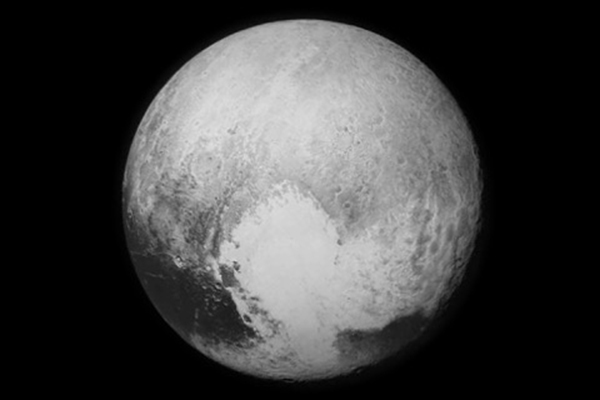


Pluto fly-by
UD professors share insights on historic and inspirational Pluto mission
2:26 p.m., July 15, 2015--Operator: “Will you accept a collect call from Pluto?” Imagine a call home from the outer reaches of our solar system to say you survived your journey.
That’s what NASA’s mission team cheered about just before 9 p.m. on Tuesday, July 14, when messages from the New Horizons spacecraft finally were received, confirming that it had accomplished the first-ever fly-by of Pluto.
Research Stories
Chronic wounds
Prof. Heck's legacy
New Horizons, which launched nearly a decade ago on a 3-billion-mile journey to Pluto, has captivated the world with stunning images showing the dwarf planet in all of its icy wonder. A fan favorite is Pluto’s “two-toned heart.” New Horizons took the photo about 7,750 miles from the orb’s surface while moving at a cool 8.5 miles per second.
But there will be much more data to come on Pluto, which was once considered the ninth planet from the sun, but was reclassified in 2006 as a “dwarf planet” — a subject of continued debate in the scientific community.
Pluto’s five known moons, including Charon, its largest, also have been imaged. NASA says it will take about 16 months to transmit all of the data from space.
John Gizis, professor, and Sarah Dodson-Robinson, assistant professor, both in the Department of Physics and Astronomy at the University of Delaware, have been following the mission with great interest and share their insights with UDaily readers.
Q. What are the biggest discoveries that New Horizons has revealed about Pluto so far?
Dodson-Robinson: The surface of Pluto is defined by interesting large-scale structures. A black feature near the equator has already been dubbed the “whale,” while there is what appears to be a white heart next to the whale. The white probably indicates ice. It's not clear why Pluto's surface should have such compositional variations.
Gizis: The initial images show that Pluto has a very complex surface showing the influence of geological and atmospheric processes. The mission has also confirmed that Pluto is the largest dwarf planet in the Kuiper Belt in terms of its size, although Eris is actually more massive.
Q. How will UD physicists/astronomers benefit from the mission and its findings?
Gizis: First of all, we will have to update our classes! In terms of new research, UD astronomers are interested in how planets form and evolve around other stars. How the Kuiper Belt in general and how Pluto and its large moon Charon specifically formed will provide insights into the planet formation process throughout the universe. In the far future as it leaves the solar system, New Horizons will measure the properties of the heliopause, where the solar wind meets interstellar space, and this will relate directly to some of the solar wind and plasma physics research at UD.
Dodson-Robinson: One of my main research areas is the composition of planets. The chemical makeup of planet nurseries helps determine the size and evolutionary pathway of planets. By learning about Pluto’s composition, we can better understand planet formation and evolution.
Q. How does New Horizons compare to Voyager, a mission that UD was involved in?
Dodson-Robinson: The Voyager spacecraft did fly-bys of the giant planets. The fly-by nature of New Horizons is similar to Voyager. However, New Horizons is the first spacecraft to study a Kuiper Belt object.
Gizis: I grew up with the Voyager fly-bys of four planets, and I hope this mission is similarly inspirational to a new generation.
Q. Based on what you’ve seen, should Pluto once again be considered a planet?
Dodson-Robinson: It was clear before the New Horizons fly-by that Pluto was fundamentally different from the other eight planets. It shares an orbit with many other objects, and it’s not even the largest dwarf planet. Calling Pluto a planet would require adding Eris, Makemake and Haumea to the list. Pluto really belongs in a different category than the eight planets, but that doesn't make it any less interesting.
Gizis: I think it makes the most sense to think of the solar system as having eight planets (plus their moons), the Asteroid Belt (including Ceres) and the Kuiper Belt (including Pluto and Eris). Pluto then gets classified as a “dwarf planet,” but remember, amazing worlds like Titan, Ganymede and Triton get called “moons” even though they’re larger than Pluto. Each of the planets, dwarf planets, moons, comets and asteroids we have studied close up with space probes has turned out to be unique.
Q. What’s on your horizon as the next big space event?
Dodson-Robinson: I’m very excited about the mission to Europa, which is a possible habitat for life. Europa almost certainly has a subsurface ocean, with abundant geothermal energy. I can’t wait for the Europa data to come back.
Gizis: Like many astronomers, I am anxiously awaiting the launch of the James Webb Space Telescope in 2018. It’s the successor to Hubble Space Telescope. Between now and then, I expect many new discoveries of planets and planet-forming disks around other stars from new instruments like Gemini Planet Imager and the Atacama Large Millimeter/submillimeter Array (ALMA).
Article by Tracey Bryant
Images of Pluto by NASA/APL/SwRI










